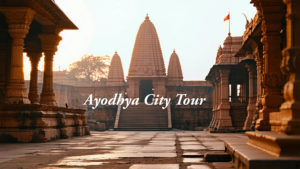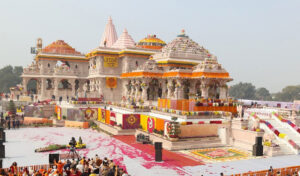Bharat Kund, Nandigram – A Divine Stop Among Ayodhya Tourist Attractions
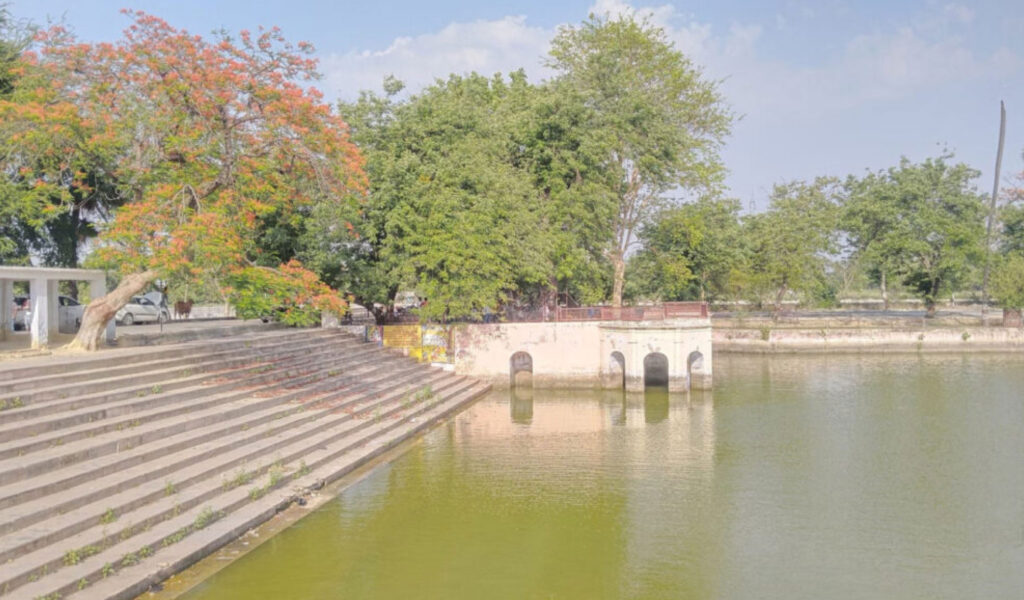
If you’re planning your journey through the sacred land of Ayodhya, seeking Ayodhya sightseeing places that combine spiritual depth and tranquility, then Bharat Kund, Nandigram deserves a top spot on your itinerary. Nestled about 15-20 km south of Ayodhya, this serene place is among the most poignant tourist spot[s] in Ayodhya you must visit.
Where Is Bharat Kund / Nandigram?
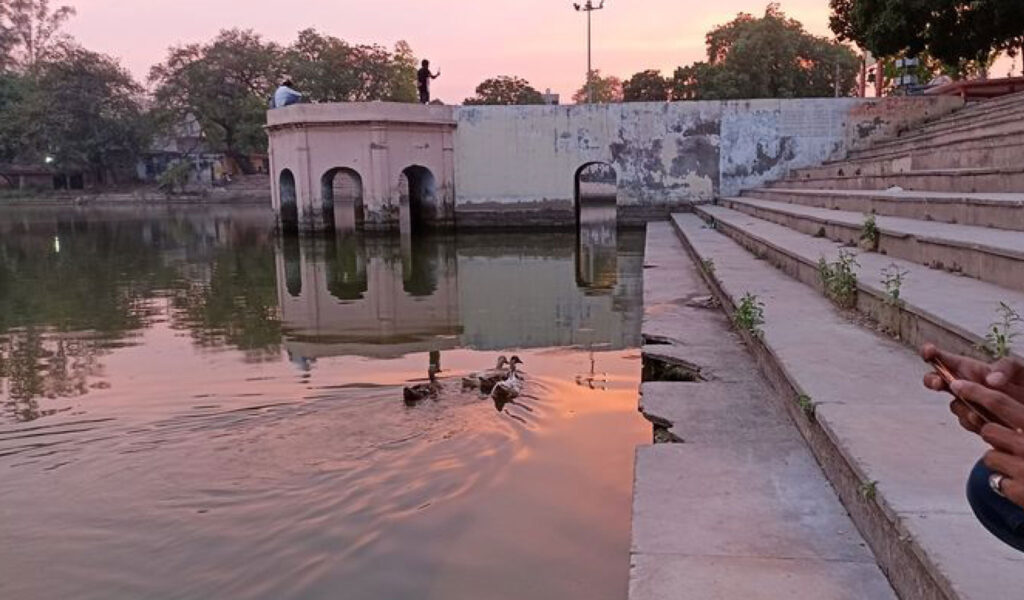
Bharat Kund, also known by its ancient name Bharatkund, is located in the peaceful village of Nandigram, in the Sohawal tehsil of Ayodhya district, Uttar Pradesh. This sacred site lies around 18–20 km south of Ayodhya city, making it an easily accessible day-trip destination for pilgrims and travelers exploring the region’s Ayodhya sightseeing places.
Geographically, Nandigram is set amidst serene rural landscapes, away from the hustle of the main Ayodhya town. The road leading to Bharat Kund passes through stretches of countryside, dotted with small temples, ponds, and farming fields, giving visitors a glimpse of the authentic culture of Awadh.
Historically, this place holds immense spiritual value. It was here that Lord Bharat, the devoted younger brother of Lord Rama, set up his base during Rama’s 14-year exile. Instead of ruling from Ayodhya’s palace, Bharat stayed in Nandigram with utmost humility, governing the kingdom symbolically by placing Rama’s wooden sandals (Padukas) on the throne. This act of devotion transformed Nandigram into a revered site, today known as Bharat Kund.
Travelers usually visit Bharat Kund not only to see the sacred pond (kund), but also to experience the calm atmosphere, temples, and ritual spots that still preserve the essence of Ramayana’s stories. With improved road connectivity, reaching Bharat Kund from Ayodhya takes about 30–40 minutes by car or taxi, making it a convenient addition to any list of Ayodhya tourist attractions.
GPS Coordinates of Bharat Kund / Nandigram
Latitude: 26.6475057° N
Longitude: 82.1468847° E
Mythological & Historical Significance of Bharat Kund
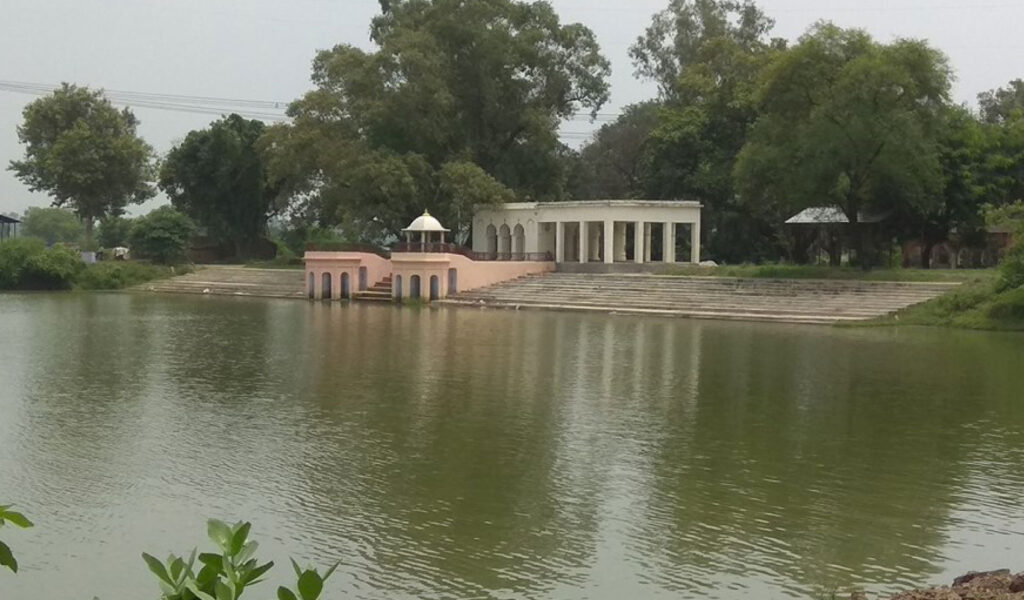
What makes Bharat Kund, Nandigram such a compelling place to visit in Ayodhya is its deep-rooted connection to the epic Ramayana and the timeless ideals of devotion, sacrifice, and duty.
1. Bharat’s Renunciation & Devotion
When Lord Rama was exiled to the forest for 14 years, his younger brother Bharat was expected to take the throne of Ayodhya. But out of immense respect and love for Rama, Bharat refused to become king. Instead, he placed Rama’s wooden sandals (Padukas) on the royal throne as a symbol of Rama’s sovereignty. Bharat then shifted to Nandigram (Bharat Kund) and ruled the kingdom as a caretaker—not in luxury, but in austerity, waiting for Rama’s rightful return.
This act of humility and selfless devotion has made Nandigram a sacred site that symbolizes ideal brotherhood and dharma (righteousness).
2. The Sacred Kund – Daily Rituals of Bharat
At the heart of Nandigram lies Bharat Kund, a large pond believed to be the place where Bharat performed his daily ablutions and holy baths during Rama’s exile. Each day, Bharat purified himself here before carrying out his royal duties in Rama’s name. Pilgrims and devotees often take a dip in this kund, considering it a way to connect with Bharat’s piety and devotion.
3. Pind Daan & Ancestral Rites
Beyond its Ramayana association, Bharat Kund is also renowned as a site for ancestral rituals (Pind Daan). Surrounding the kund are several smaller ponds, wells, and ghats, each associated with rituals performed for the peace of departed souls. Because of this, the site is sometimes called “Chhota Gaya”, drawing parallels with the famous Gaya in Bihar where similar rites are performed.
During Pitru Paksha, thousands of devotees gather at Bharat Kund to perform shraddh and tarpan, believing that the rituals here bring salvation to their ancestors.
4. Cultural & Religious Importance
The sanctity of Bharat Kund goes beyond rituals. It is seen as a living reminder of dharma, humility, and devotion—values embodied by Bharat in the Ramayana. Festivals, fairs, and local rituals keep the place alive, and priests often narrate stories of Bharat’s sacrifice to visitors.
In essence, Bharat Kund is not just a pond or a village—it is a symbol of selfless love, faith, and duty, making it one of the most meaningful Ayodhya tourist attractions for pilgrims and history lovers alike.
Architecture of Bharat Kund (Nandigram)
The architectural layout of Bharat Kund is centred on its sacred pond, believed to be where Bharat performed daily rituals during Lord Rama’s exile. The kund is encircled by stone ghats, designed for ritual bathing and Pind Daan ceremonies. Small temples and shrines—including Bharat Mandir and Ram-Janaki Mandir—stand around the pond, displaying simple yet devotional North Indian styles. The Gaya Koop (sacred well) nearby is another architectural feature used for ancestral rites. The quiet rural landscape frames these elements, making Bharat Kund an authentic example of functional religious architecture tied to mythology.
What You’ll See & Do at Bharat Kund
When you include Bharat Kund, Nandigram in your Ayodhya sightseeing tour, you’ll discover that this sacred spot offers not just history and myth, but also a unique blend of spirituality and serenity. Here’s what you can expect:
1. The Kund (Sacred Pond)
At the heart of the site lies Bharat Kund, a large water body surrounded by stone ghats and steps. This is believed to be the very pond where Lord Bharat performed his daily bath and rituals during Lord Rama’s exile. Even today, pilgrims gather here for holy dips, prayers, and rituals like tarpan. The calm waters and the spiritual aura make it a place for quiet reflection. Many visitors simply sit by the steps, watching rituals unfold or meditating in the tranquil atmosphere.
2. Temples & Shrines
Around the kund, you’ll find a cluster of small temples and shrines that add to the site’s sacred charm. Notable among them are:
•Bharat Mandir – dedicated to Bharat, honoring his devotion and sacrifice.
•Ram Janaki Mandir – celebrating the divine couple, Lord Rama and Goddess Sita.
These shrines allow visitors to experience the local devotional traditions and connect deeply with the Ramayana’s legacy. Many priests here also narrate the story of Bharat’s renunciation, making your visit spiritually enriching.
3. Gaya Koop (The Sacred Well)
One of the most important ritual spots is the Gaya Koop, a sacred well associated with Pind Daan (ancestral offerings). Much like the famous rituals performed in Gaya (Bihar), devotees come here to perform last rites and seek peace for their ancestors’ souls. Because of this, Bharat Kund is sometimes lovingly referred to as “Chhota Gaya”. During Pitru Paksha, this area comes alive with large gatherings of families performing rituals guided by priests.
4. Bharat–Hanuman Meet Point
According to local legends, Bharat and Hanuman met here during Rama’s exile. Hanuman is believed to have come bearing news of Lord Rama, and this meeting has been immortalized with small shrines and symbolic sites. Visiting these places allows you to relive one of the less-known but fascinating moments of the Ramayana.
5. Quiet Nature & Scenery
Unlike the busy ghats of central Ayodhya, Bharat Kund offers a refreshing escape into peaceful natural surroundings. The area is dotted with:
•Tall trees providing shade and a calm setting for meditation.
•Small water bodies apart from the kund, adding to the rustic charm.
•Fields and open spaces that reflect the rural beauty of Uttar Pradesh.
This natural environment, combined with spiritual energy, makes Bharat Kund an ideal spot for prayer, introspection, or simply unwinding after visiting Ayodhya’s more crowded attractions.
In short, a visit to Bharat Kund, Nandigram is not just about sightseeing; it’s about experiencing devotion, rituals, and peace in one of the most meaningful Ayodhya tourist attractions.
How to Reach Bharat Kund / Nandigram (Using the Coordinates)
You can enter the above GPS coordinates in Google Maps or any navigation app. Here are some route/directions tips:
•If starting from Ayodhya city centre, set your destination as 26.6475057, 82.1468847.
•You will travel roughly 19 km south from the city.
•The route mostly follows the Prayagraj road / NH-330 (or the road heading toward Sultanpur from Ayodhya) before you veer off toward Nandigram.
•Nearest railway station: Bharatkund Railway Station (BTKD) which is close by.
•If coming from farther away, your nearest major airport may be Ayodhya International Airport or Lucknow’s Chaudhary Charan Singh Airport. From there, take road transport to Ayodhya → then follow the above route.
How to Reach & Best Time to Visit
•Getting there: Bharat Kund is easily accessible by road from Ayodhya, via Prayagraj road. The road connectivity is good.
•Best time: Early mornings or late afternoons are ideal—for the light, calmness and to avoid crowds. Pitru Paksha is especially busy for those doing ancestral rites. Also, avoid the height of summer; cooler months (October-March) are more comfortable.
Why Bharat Kund Is One of Ayodhya’s Must-See Tourist Spots
•It offers a unique spiritual dimension beyond temples: it is tied to deep mythological emotion (Bharat’s sacrifice, waiting, ruling in proxy) which many standard “Ayodhya places to see” cannot match.
•The combination of heritage + ritual + natural calm makes it a contrast to the high ritual activity in central Ayodhya (Ram Janmabhoomi, etc.).
•For travelers looking for off-beat yet meaningful Ayodhya tourist spot[s], Bharat Kund gives both history and peace.
Other Ayodhya Tourist Attractions Nearby
To make the most of your trip, you can combine a visit to Bharat Kund with other top Ayodhya tourist attractions:
•Ram Janmabhoomi – The birthplace of Lord Rama. A focal point of devotion and pilgrimage.
•Hanuman Garhi – A hilltop temple with views, spirituality, and legend.
•Kanak Bhawan – Known for its beautiful architecture, golden icons, and as one of the holiest Ayodhya places to see.
•Ram Ki Paidi / Saryu River Ghats – For the River-front experience, rituals, bathing ghats, evening aarti, etc.
Suggested One-Day Itinerary: Ayodhya with Bharat Kund, Nandigram
Morning
•Start your day at Ram Janmabhoomi – visit the sacred birthplace of Lord Rama.
•Walk to Kanak Bhawan, known for its golden idols and divine architecture.
•Head to Hanuman Garhi, a hilltop temple offering panoramic views of Ayodhya.
Late Morning
•Drive towards Bharat Kund, Nandigram (about 19 km from Ayodhya).
•Explore the sacred kund, temples, and sites linked with Lord Bharat.
•If desired, participate in or witness rituals like Pind Daan.
Afternoon
•Return to Ayodhya city for lunch at a local restaurant.
•Rest briefly or stroll around the vibrant streets near Hanuman Garhi.
Evening
•Visit Ram Ki Paidi and the serene Saryu River Ghats.
•Take part in or witness the enchanting evening aarti on the ghats.
•Enjoy the peaceful riverfront views as the day ends.
This itinerary balances Ayodhya’s main tourist attractions with the spiritual calm of Bharat Kund, giving you both heritage and serenity in one day.
Tips & Traveler Advice
•Wear modest, comfortable clothes (especially when visiting temples and performing any religious rites).
•If you plan to perform Pind Daan or ancestral rites, check the local priest’s timings and availability.
•Carry water, sunscreen, hats — Ayodhya can get hot, and Bharat Kund area has less shade.
•Check for local events or festivals — things like Pitru Paksha, Amavasya, etc., as these may draw extra crowds but also add to the spiritual ambience.
•Respect the rituals and local customs — photography may be allowed/not in certain areas; be mindful.
Frequently Asked Questions (FAQ) About Bharat Kund, Nandigram
1.What is Bharat Kund / Nandigram?
Bharat Kund (also known as Nandigram) is a holy site near Ayodhya, in Sohawal tehsil, Uttar Pradesh. It is believed to be the place where Lord Bharat, the brother of Lord Rama, lived and ruled in Lord Rama’s absence during the 14-year exile.
2.Why is it called “Bharat Kund”?
The name comes from Lord Bharat. It is believed that during Lord Rama’s exile, Bharat governed the kingdom from Nandigram by placing Rama’s sandals (padukas) on a throne called a “chowki.” The kund (pond) is associated with Bharat’s daily routines and rituals.
3.What is the mythological significance of this place?
•Bharat’s devotion: He refused to ascend the throne of Ayodhya while Rama was still in exile. Instead, he ruled from Nandigram, keeping Rama’s padukas as symbolic king.
•Pind Daan / ancestral rites: The pond and wells here are used for rituals related to ancestors, especially during Pitru Paksha.
•Meeting of Bharat & Hanuman: There are temples and sites commemorating the meeting between Bharat and Hanuman.
4.How far is Bharat Kund from Ayodhya city?
Distances vary slightly in different sources:
•~15 km from Ayodhya according to Ayodhya-Dham site.
•~20–22 km in other sources.
5.How to reach Bharat Kund? What are travel options?
•By road: It is well-connected by road from Ayodhya. You can take a taxi, private vehicle or possibly local buses.
•It lies near or along the Prayagraj road / NH connectivity.
6.When is the best time to visit?
•Cooler months: October through March are more pleasant. Summer can be very hot.
•For ritual and religious significance: Pitru Paksha is when many devotees come for Pind Daan.
•Early morning or evening for peace, less crowd.
7.Are there specific opening and closing times / timings for rituals?
•I did not find a consistently confirmed official opening/closing schedule for the kunds, temples etc., from government sources. Some sources suggest aarti in the evening (~6:30 pm) at Bharat Kund.
•It’s safer to assume early morning opening (pre-dawn in many Indian temples) to early night, but check locally before visiting.
8.What rituals or religious practices can visitors do there?
•Bathing in the kund (holy water) for purification.
•Pind Daan (offerings for ancestors), especially during Pitru Paksha.
•Asthi Visarjan (immersing ashes of departed) by some sites/rivers/wells around.
•Temple puja / darshan (worship), visiting Bharat Mandir, meeting points, etc.
9.Is there any entry fee? Do I need permission?
•From available sources, there is no mention of a mandatory entry fee for visiting Bharat Kund or Nandigram. It seems to be public holy space.
•There might be charges for special ceremonies or offerings; usually handled locally.
10.Are there facilities / amenities?
•Basic amenities like ghats / steps to approach the pond, small temples, wells, etc.
•Shade, greenery around. Some wells, kunds have stairs.
•Limited tourist infrastructure; it may lack extensive commercial amenities. Plan accordingly.
11.Is it safe to bathe in the kund?
•The kund has stairs/ghats for bathing and ritual access. But some sources caution: “deep kund, if you don’t know swimming please don’t go deep inside.”
•Also hygiene, water quality may vary; precaution advised.
12.Are there accommodations nearby?
•Within Ayodhya city there are many lodging options; Nandigram / Bharat Kund is more of pilgrimage / heritage site, so fewer or more basic lodgings very close by.
•Best to stay in Ayodhya city and travel to Bharat Kund as a day-visit.
13.What are some other nearby places to see in / around Nandigram / Ayodhya?
•Bharat Gufa (cave): Where Bharat is said to have lived in penance.
•Gaya Koop: A well for ancestor rituals (Pind Daan).
•Bharat Mandir and Ram Janaki Mandir in Nandigram.
•Charan Paduka (footprints / padukas of Rama) sites.
14.What is “Bharat Path” project & will it affect access?
•The UP government has proposed the Bharat Path / spiritual corridor project (~20 km) connecting Bharat Kund (Nandigram) with Ranopali etc., to improve access, infrastructure, roads.
•Once built, this should make travel easier and likely increase facilities.
15.What is the postal code, local administrative details?
•Nandigram / Bharatkund’s postal code is 224202.
•It is a village and religious place in Sohawal tehsil, Ayodhya district, UP.
16.Is the place crowded / what is the best time of day to avoid crowds?
•During festivals, Pitru Paksha, particular religious occasions, it gets crowded.
•Early mornings or late afternoons are better for a more peaceful experience.
17.Can non-Hindus visit / participate?
•Yes, visitors of any faith can go there to see the site, enjoy its heritage, and learn about its mythological background. Ritual participation may require following local customs, but access is generally open.
•Dress modestly, respect local customs.
18.Are there guided tours / local guides available?
•Many Ayodhya-tourism websites and local tour operators include Bharat Kund / Nandigram in their itineraries. Local guides are available, especially around Ayodhya.
•It’s helpful to engage one, particularly if you want deeper mythological / historical context.
19.What languages are spoken locally?
•Hindi is the main local language. English may be used in tourist settings.
20.Is there drinking water/restrooms/food near the site?
•Basic facilities likely present in and near local villages; but availability may be limited. Best to carry water, snacks. Larger food options are more in Ayodhya city.
21.What is the significance of the banyan tree near the well / kund?
•In Ayodhya Dham site there is mention of a centuries-old banyan tree near the well in Bharat Kund, under which branches are believed to show images of gods.
22.Is photography allowed?
•Generally yes for public areas and ghats; inside some temples or during rituals there may be restrictions. Best to ask onsite.
23.What should I carry / travel tips?
•Wear modest, comfortable clothing.
•Good footwear, sunscreen, water.
•Be prepared for walking / uneven surfaces.
•Plan schedule around rituals, timings; check local info before travelling.
24.Is there any myth or uncertainty / controversy about precise sites?
•Yes, for example, there are multiple temples / locations claimed to be the exact “Bharat’s cave” or “Bharat Mandir” etc. The exact historical veracity is based on tradition, myth, Ramayana accounts—scholars may differ.
25.Why is the place also called “Chhota Gaya”?
•Because of its role in ancestral rituals (Pind Daan) similar to Gaya, some sources refer to Bharat Kund as “Chhota Gaya” (small Gaya).
Conclusion
If you are looking for more than just the famous tourist spots in Ayodhya, Bharat Kund, Nandigram provides an experience that lingers — the emotion of waiting, the simplicity of devotion, the stillness of nature and water. It’s a place to visit in Ayodhya that enriches your pilgrimage or heritage trip in unexpected ways.
Visiting Bharat Kund alongside Ayodhya’s more popular Ayodhya places to see lets you see both the devotional heart and the quieter, meaningful fringes of this ancient city.

